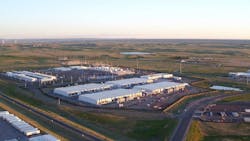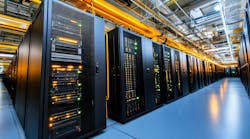Microsoft Knows Future of Data Center Power Will Be 'Everything Everywhere All at Once'
As movie fans know, it's Oscar season again, the time period in which Hollywood studios promote or release the films they consider most likely to be critically acclaimed, hoping to win big at the Academy Awards.
The title of last year's Best Picture winner, "Everything Everywhere All at Once," could've been dreamed up by the data center industry, and produced by...Microsoft?
Everyone now knows the data center industry is up against a frightening power crunch in the world's oncoming AI sweepstakes. The quandary isn't so much one of power capacity, which is furnishable, as much as it is specifically tied to the area of available transmission lines and sites' proximity to plentiful power from renewable sources.
This trend was described and exemplified by DCF founder Rich Miller's recent article breaking down Dominion Energy's approach to the condundrum as it's playing out in the environs of global data center industry frontrunner, Northern Virginia.
It was also recently recounted by Bisnow's Dan Rabb in an article earlier this month declaring that "the data center power crunch [is getting] worse, with no end in sight," based on observations made in wrapping up the publication's DICE Data Center Management, Operations and Cooling conference in Virginia last December.
Per recent data from McKinsey, fueled by AI amid the expansion of the traditional cloud, the power requirements of U.S. data centers are projected to more than double from 17 gigawatts (GW) in 2022 to 35 GW by 2030. But Rabb's article emphasizes how such an awareness of the data center power crunch wasn't always the case, in the days before last year's industry-wide generative AI inflection point, as ushered in by ChatGPT.
And as reported by Rabb, utilities in major data center markets were taken completely by surprise by the explosion of demand from the sector over the past three years, as related by Microsoft's Yue Tu, Product Innovation Manager, as quoted at the Bisnow event:
“Every utility was the same story: they were projecting very flat demand growth and maybe even some small decreases over the next decade due to energy efficiency. I remember sitting down with a utility executive in 2018 and asking if they were ready for one gigawatt of new demand coming in the next five years. He didn’t think I was serious.”
As DCF's Rich Miller further explained in his recent 2024 data center trends forecast:
"Utilities are struggling to upgrade transmission networks to support the surging requirement for electricity to power data centers. CBRE says data center construction completion timelines have been extended by 24 to 72 months due to power supply delays [...]
“We can’t rely on just the grid anymore,” Digital Bridge CEO Marc Ganzi told Bloomberg Markets. “We’ve got to be able to take things into our own hands, protect our supply chain, and deliver for our customers [...] If you’re not building data centers adjacent to low-cost renewable power, you’re not going to have a fruitful conversation with the hyperscalers and cloud players. ”
So with the scene thus set of an industry-wide power crisis with no end in sight, now enters a pair of news announcements over just the past couple of weeks which again demonstrate how Microsoft, especially among hyperscalers, is committed to the idea that power generation to support future data centers isn't and won't be an "either/or" proposition -- but rather, "all of the above."
Lots of cloud giants are probably committed to that ethos -- but Microsoft has quickly moved in on it, within a very short timeframe.
Caterpillar, Ballard Prove Out Hydrogen Fuel Cells for Battery Backup at Microsoft Wyoming Data Center
Any tangible developement in hydrogen power for data center battery backup purposes perks our interest, but recent news of the further demonstrated viability of using hydrogen fuel cell technology for backup power, this time at a Microsoft data center in Cheyenne, Wyoming, also raised eyebrows just for featuring diesel generator stalwart Caterpillar as project lead, who was seen as recently as 2021 helping to pour eco-diesel fuel into Microsoft's generators for its cloud region in Sweden.
Such reports emphasize how Caterpillar also "gets it" regarding the "Everything Everywhere" trope for prescribing data center power quandaries. So it came as no absolute surprise when on January 19, Caterpillar announced its successful collaboration with Microsoft and Ballard Power Systems to demonstrate the successful use of large-format hydrogen fuel cell technology to supply reliable and sustainable backup power for data centers.
Caterpillar led the project in icy Wyoming as "conducted in a challenging environment," providing the overall system integration, power electronics, and microgrid controls that form the central structure of the hydrogen power solution.
"This successful collaboration with Microsoft and Ballard demonstrates the potential of hydrogen fuel cells to help data centers address their critical power needs while reducing their emissions," said Jaime Mineart, senior vice president of Caterpillar Electric Power.
The project simulated a 48-hour backup power event at Microsoft's data center in Cheyenne, where a hydrogen fuel cell was integrated into a data center electrical plant to support its critical load.
The demonstration validated the hydrogen fuel cell power system's performance at 6,086 ft (1,855 m) above sea level and in below-freezing conditions.
The partners said the demonstration provided valuable insights into the capabilities of fuel cell systems to power multi-megawatt data centers, ensuring an uninterrupted power supply to meet 99.999% uptime requirements.
In the demonstration, a Caterpillar Microgrid Controller was used to operate two of the company's Cat® Power Grid Stabilization (PGS) 1260 battery energy storage systems, along with the 1.5 MW hydrogen fuel cell.
Such play in the arena of hydrogen for data center power is of course well-trod ground for Microsoft, who as far back as 2022 successfully tested a 3-megawatt generator using hydrogen fuel cells, proving that the technology can work at data center scale.
That 3-megawatt hydrogen fuel cell, developed for Microsoft by Plug Power, and on course to replace diesel generators in Microsoft data centers, was at the time heralded by DCF as the latest in a series of Microsoft “moonshot” R&D projects designed to rethink the future of sustainable data centers.
With the Caterpillar announcement, the Microsoft data center hydrogen project's optimism becomes that much more tangible and grounded.
"This project's success provides an opportunity for hyperscale providers to drive innovations in the sustainability of power generation technologies," said Sean James, Senior Director of Data Center Research at Microsoft. "The research and findings of the hydrogen fuel cell demonstration will help us towards our goal of becoming carbon negative by 2030."
The project is supported and partially funded by the U.S. Department of Energy Hydrogen and Fuel Cell Technologies Office (DOE) under the H2@Scale initiative, which brings stakeholders together to advance affordable hydrogen production, transport, storage and utilization in multiple energy sectors.
DCF's David Chernicoff also recently reported DOE's recent green hydrogen initiatives. During the demonstration by Caterpillar and Ballard at Microsoft's data center in Cheyenne, the DOE's National Renewable Energy Laboratory (NREL) analyzed safety, techno-economics, and greenhouse gas (GHG) impacts.
"We see the completion of this demonstration as an important proof point of the reliability and durability of Ballard's fuel cells in providing zero-emission backup power for data centers," said David Mucciacciaro, Chief Commercial Officer of Ballard Power Systems. "We are excited about the ability of our products to meet the critical power needs of data center customers in this rapidly growing sector."
The Caterpillar announcement is just another compelling scene in the panorama of Microsoft's volume of R&D innovation to create greener data centers. Starting from at least 2020, these projects have included:
Grid-Interactive UPS Systems: Microsoft in recent years revealed its data centers would begin sharing energy from their UPS battery storage systems with Ireland’s power grid, part of a growing movement for data centers to collaborate more closely with the utility industry.
Data Center Microgrids: Microsoft announced plans to integrate a microgrid at a new data center in San Jose, Calif., using renewable natural gas (RNG) instead of diesel fuel to power its emergency backup generators. The project with Enchanted Rock advances Microsoft’s goal of moving off diesel fuel by 2030.
Cleaner Generator Fuel: While it advances its development of microgrids and hydrogen fuel cells, Microsoft also committed to begin using lower-carbon renewable fuel for data center generators at its cloud region in Sweden.
Slashing Water Usage: The company pledged to reduce the use of water in its data centers by 95 percent by 2024 by refining how it designs and operates its massive cloud infrastructure. including operating its data centers at warmer temperatures.
Using Immersion to Cool Servers: That Microsoft had begun using immersion-cooled servers in production was revealed in 2022. The announcement represented a meaningful milestone for adoption of two-phase immersion, which promises major gains in density and efficiency, and will also reduce the water use of its computing operations. Immersion may also help servers run faster by enabling more overclocking of processors.
Next-Generation Data Storage: Microsoft is known to be working on new storage technologies to house massive amounts of data in DNA and holograms. These storage technologies could disrupt how data centers are designed and operate.
Low-Carbon Buildings: Timely research from Microsoft has outlined the potential use of sustainable material in data center construction projects to create low-carbon cloud infrastructure. It is exploring the use of mushrooms, algae, agricultural waste and hemp as structural materials.
Microsoft’s underwater data center Project Natick, which pushed the boundaries of where the cloud could live, and also found that servers housed in a sealed nitrogen environment were substantially more reliable than those in traditional data centers.
Microsoft Appoints Leaders for Data Center Nuclear Power Program
After a year in which the federal government's small modular reactor (SMR) nuclear standard-bearer NuScale crashed down from gathering data center clients to gathering notices for lawsuits (due to failed deals and as blowback from a notorious short-seller stock-price assassination write-up), Microsoft has now righted the SMR and microreactor ship of state (so to speak) with a pair of key hirings to lead its data center nuclear energy development efforts.
When Microsoft announced last fall that it was looking to hire a leader for its SMR program, many close industry watchers assessed it as a tipping point for data center nuclear power generation stakes. So word of the company's selection of Archie Manoharan as its new Director of Nuclear Technologies came with a sense of vindication, and even completion, following as it did on the heels of Microsoft's December appointment of Erin Henderson to lead its nuclear development acceleration efforts, whom Manoharan will work alongside.
Prior to Microsoft, Manoharan was Director of Nuclear Strategy and Programs for startup Ultra Safe Nuclear (USNC), a developer of micro modular reactors. There she managed long-range nuclear strategic plans and key stakeholder partnerships for USNC Micro Modular Reactor (MMR) deployments. She also managed key stakeholder communications for strategic partnerships, and formal agreements consistent with USNC objectives in pursuit of ambitious green energy solutions, and managed UNSC's Department of Energy (DOE) loan program application efforts.
Erin Henderson joined Microsoft in December as Director of Nuclear Development Acceleration. She is energy sector veteran who comes to Microsoft after thirteen years of tenure at the Tennessee Valley Authority, where she most recently served as general manager of transmission projects.
About the Author
Matt Vincent
A B2B technology journalist and editor with more than two decades of experience, Matt Vincent is Editor in Chief of Data Center Frontier.


